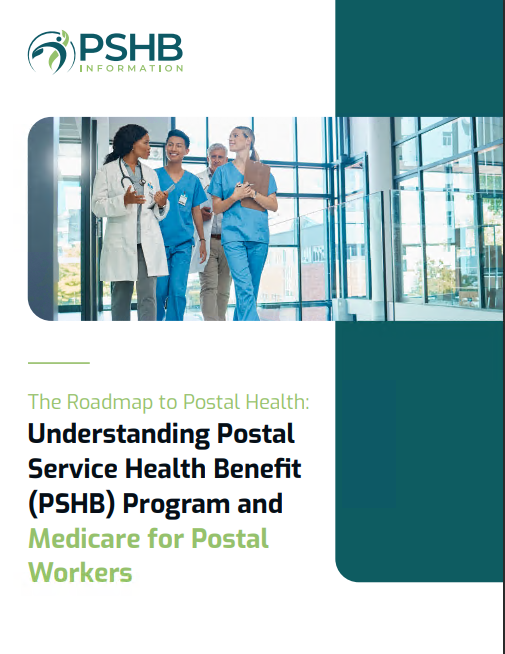Key Takeaways
-
PSHB and Medicare can work together to give you better coverage, but only if you understand how each program works and how they interact.
-
Knowing what’s covered under each plan and what isn’t can help you avoid out-of-pocket surprises and make smarter healthcare choices.
Understanding the Basics: PSHB and Medicare
If you’re a United States Postal Service employee or retiree, you’re likely already aware that the Postal Service Health Benefits (PSHB) Program replaced the FEHB for USPS workers starting in 2025. It’s a big change—and it comes with questions, especially when it comes to how PSHB works with Medicare.
Medicare kicks in for most people at age 65, but PSHB is your employer-sponsored plan. The two don’t replace each other, but they can complement each other. The trick is knowing how to use them both effectively.
What PSHB Covers
PSHB is designed with USPS employees and retirees in mind. It offers comprehensive medical coverage, and here’s a general look at what’s included:
-
Inpatient and outpatient hospital care
-
Primary and specialist doctor visits
-
Emergency room and urgent care visits
-
Preventive care services
-
Mental health and substance use disorder treatment
-
Prescription drug coverage
-
Lab work and diagnostic tests
-
Some plans offer dental and vision benefits
The coverage can vary by plan, especially when it comes to deductibles, coinsurance, and copayments. If you’re retired, you’re still eligible for PSHB, and your premiums may differ, but your access to benefits remains strong.
What Medicare Covers
Medicare comes in parts:
-
Part A (Hospital Insurance): Covers inpatient hospital stays, skilled nursing care, hospice, and some home health care. Most people don’t pay a premium for Part A if they’ve worked long enough.
-
Part B (Medical Insurance): Covers doctor visits, outpatient care, preventive services, and some home health services. There’s a monthly premium and an annual deductible in 2025.
-
Part D (Prescription Drug Coverage): Covers many prescription drugs, though formularies and coverage levels differ.
-
Part C (Medicare Advantage): Not a standalone part, but rather a bundled option offered by private insurers that includes Parts A and B, usually D, and sometimes extras like dental and vision.
If you’re a USPS retiree who’s eligible for Medicare, it’s crucial to sign up for Part B to stay enrolled in PSHB. Starting in 2025, that’s a requirement for annuitants unless you fall under a specific exemption.
What’s Not Covered: Gaps You Should Know
Both PSHB and Medicare offer solid coverage, but neither is perfect. Here’s what may not be covered:
Under PSHB
-
Long-term custodial care
-
Cosmetic procedures
-
Experimental treatments or unapproved drugs
-
Some overseas care (unless under certain emergencies)
Under Medicare
-
Long-term care (nursing home custodial care)
-
Dental, vision, and hearing (unless you have a separate plan or Advantage plan that includes it)
-
Routine foot care
-
Acupuncture (outside specific conditions)
Understanding these gaps can help you plan better. You may want to consider supplemental insurance or budget for out-of-pocket expenses.
How PSHB and Medicare Work Together
When you have both, coordination of benefits kicks in. Here’s how that generally plays out:
-
Medicare is primary if you’re retired and 65 or older.
-
PSHB is secondary, filling in many of the gaps Medicare leaves behind.
-
In many cases, having both means you pay less out-of-pocket because PSHB may cover deductibles, coinsurance, and copayments.
-
Some PSHB plans waive certain costs entirely if Medicare is your primary coverage.
This coordination means that when used together, Medicare and PSHB can dramatically reduce your healthcare expenses—if you’re enrolled correctly.
Timing Matters: Enrollment Deadlines and Consequences
USPS retirees are now required to enroll in Medicare Part B to keep their PSHB coverage, unless:
-
You retired on or before January 1, 2025, and aren’t already enrolled.
-
You turn 65 in 2025 but qualify for a specific exception.
If you don’t enroll in Medicare Part B when first eligible, you may:
-
Lose access to PSHB coverage
-
Face late enrollment penalties from Medicare
-
Be forced to wait for Medicare’s General Enrollment Period (January 1–March 31), with coverage beginning in July
Mark your calendar around your 65th birthday and review your Medicare eligibility window (3 months before, the month of, and 3 months after turning 65).
Prescription Drugs: Where Coverage Overlaps—and Where It Doesn’t
Prescription drug coverage can be confusing when you’re dealing with both PSHB and Medicare. Here’s how it generally works:
-
If you’re Medicare-eligible and enrolled in a PSHB plan, your prescription drug coverage may automatically switch to a Medicare Part D Employer Group Waiver Plan (EGWP).
-
This EGWP may offer better coverage and lower out-of-pocket costs compared to standard Part D plans.
-
PSHB drug plans typically cover both brand-name and generic medications and include mail-order options.
Always check your plan’s formulary and compare it to what’s covered under Medicare Part D.
Out-of-Pocket Costs: What You’ll Still Have to Pay
Even with both PSHB and Medicare, you’ll still have some costs, such as:
-
Medicare Part B premium (standard in 2025 is $185/month)
-
Medicare Part B deductible ($257 in 2025)
-
Medicare Part D deductible (up to $590 in 2025)
-
PSHB plan premiums (varies based on plan and enrollment tier)
-
Copayments and coinsurance, though often reduced when both coverages apply
Some PSHB plans offer Part B premium reimbursements or cost-sharing reductions, but not all. Read your plan brochure carefully.
Dental, Vision, and Hearing: Don’t Overlook These Gaps
While some PSHB plans include dental and vision benefits, Medicare doesn’t typically cover them.
-
Dental: Routine exams, cleanings, and major dental work aren’t covered under Medicare.
-
Vision: Medicare only covers eye exams for diabetes and certain conditions.
-
Hearing: Medicare doesn’t cover hearing aids or exams for fitting them.
If you rely solely on Medicare, you’ll likely need to purchase a separate plan or pay out-of-pocket for these services. PSHB may fill this gap, but coverage depends on the specific plan you choose.
Travel and Emergency Coverage: Are You Protected?
If you’re traveling or living part-time in another state (or even abroad), coverage under PSHB and Medicare works differently:
-
Medicare: Covers care in the U.S. and its territories. It generally does not cover care abroad unless in specific situations (like a medical emergency near the border).
-
PSHB: Some plans offer global emergency coverage or partner with international providers.
If you plan to travel frequently, choose a PSHB plan that includes global coverage or look into travel medical insurance.
Making the Most of Both Plans
If you want to squeeze the most value out of having both PSHB and Medicare, follow these tips:
-
Enroll in Medicare Part A and B as soon as you’re eligible.
-
Choose a PSHB plan that coordinates well with Medicare.
-
Review your plan materials each Open Season (November–December).
-
Look into added perks, like wellness programs or care coordination.
-
Keep track of your deductibles and out-of-pocket maximums to avoid surprises.
Open Season: Your Annual Opportunity to Reevaluate
Every year from November to December, you get a chance to switch PSHB plans. Here’s what to do during Open Season:
-
Compare benefits and out-of-pocket costs for your current PSHB plan vs. others
-
Check how each plan coordinates with Medicare
-
Look at whether the plan offers Medicare integration perks (like lower deductibles or premium reimbursements)
Even if you’re happy with your current plan, it’s smart to review your options. A better fit could be waiting.
Final Thoughts on Getting the Balance Right
Using PSHB and Medicare together doesn’t have to be complicated, but it does take some effort to get it right. Knowing what’s covered, understanding your responsibilities, and making time to review your plan each year can make a huge difference in your healthcare experience.
If you’re not sure what to do next, don’t hesitate—get in touch with a licensed agent listed on this website for expert help tailored to your situation.








